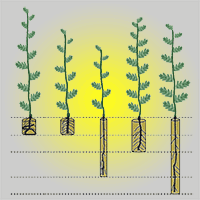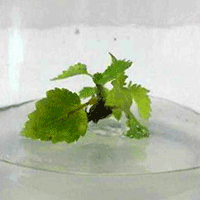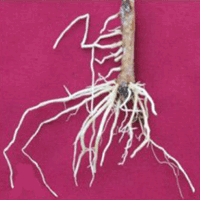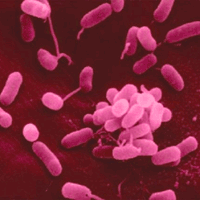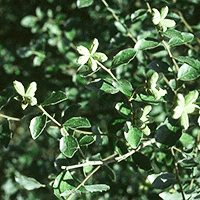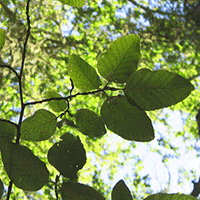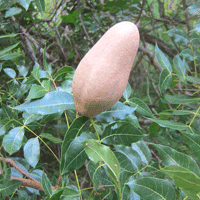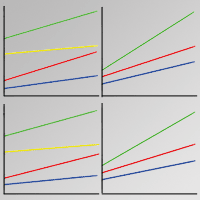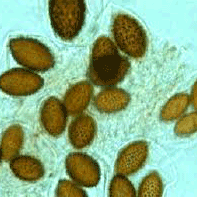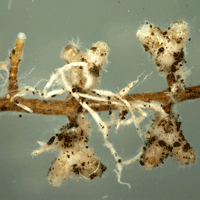The size of a container determines the development and quality of root systems. In the case of taprooted forest species used for dryland reforestation, deeper containers may favour early root development and, consequently, better soil profile colonization after outplanting. Although research on container design for worldwide tree species has been developed in the last decades, technical solutions for containerized forest species with a taproot system have been poorly documented. We present a case study using Acacia caven (Mol.) Mol., which has fast-growing taproots and long lateral and superficial roots. The aim of this study is to evaluate the effects of different containers on rooting volume in the early morphological development of A. caven seedlings. Ten day-old seedlings were cultivated in five different PVC container types varying in volume, width and length (T440-Short, T440-Long, T880-Short, T880-Long, and T440-C), in a completely randomized design for one growing season. At the end of the study, whole seedling samples were destroyed to assess taproot length, lateral root biomass, and total root/shoot dry biomass. To evaluate the potential plant capacity for developing new roots, a subsequent experiment using the root growth potential test was performed successfully. Results showed that change in root volume distribution (short vs. elongated containers) had the greatest influence on seedling quality, whereas the size of container (small volume vs. large) was of minor importance. Elongated containers (35 cm to 40 cm in length) with self-pruning basal roots produced seedlings with smaller shoot/root ratios, longer root systems, and a greater ability to restart new root growth in deeper container strata. Elongated containers also prevented taproot deformation. The present study suggests that it would be appropriate to rethink container design for seedlings of deep-rooted xerophytic species destined for water-limited transplanting conditions.
Keywords
, , ,
Citation
De La Fuente LM, Ovalle JF, Arellano EC, Ginocchio R (2017). Use of alternative containers for promoting deep rooting of native forest species used for dryland restoration: the case of Acacia caven. iForest 10: 776-782. - doi: 10.3832/ifor2101-010
Academic Editor
Gianfranco Minotta
Paper history
Received: May 02, 2016
Accepted: Jun 15, 2017
First online: Sep 02, 2017
Publication Date: Oct 31, 2017
Publication Time: 2.63 months
© SISEF - The Italian Society of Silviculture and Forest Ecology 2017
Open Access
This article is distributed under the terms of the Creative Commons Attribution-Non Commercial 4.0 International (https://creativecommons.org/licenses/by-nc/4.0/), which permits unrestricted use, distribution, and reproduction in any medium, provided you give appropriate credit to the original author(s) and the source, provide a link to the Creative Commons license, and indicate if changes were made.

Breakdown by View Type
(Waiting for server response...)
Article Usage
Total Article Views: 50379
(from publication date up to now)
Breakdown by View Type
HTML Page Views: 41403
Abstract Page Views: 3862
PDF Downloads: 4011
Citation/Reference Downloads: 17
XML Downloads: 1086
Web Metrics
Days since publication: 3064
Overall contacts: 50379
Avg. contacts per week: 115.10
Article Citations
Article citations are based on data periodically collected from the Clarivate Web of Science web site
(last update: Mar 2025)
Total number of cites (since 2017): 14
Average cites per year: 1.56
Publication Metrics
by Dimensions ©
Articles citing this article
List of the papers citing this article based on CrossRef Cited-by.
(1)
Aghai MM, Pinto JR, Davis AS (2014)Container volume and growing density influence western larch (
Larix occidentalis Nutt.) seedling development during nursery culture and establishment. New Forests 45: 199-213.
CrossRef |
Gscholar
(2)
Akpo E, Stomph TJ, Kossou DK, Omoreb A, Struik P (2014)Effects of nursery management practices on morphological quality attributes of tree seedlings at planting: the case of oil palm (
Elaeis guineensis Jacq.). Forest Ecology and Management 324: 28-36.
CrossRef |
Gscholar
(3)
Armesto JJ, Pickett S (1985)A mechanistic approach to the study of succession in the Chilean matorral. Revista Chilena de Historia Natural 58: 9-17.
Gscholar
(4)
Aronson J (1992)Evolutionary biology of
Acacia caven (Leguminosae, Mimosoideae): infraspecific variation in fruit and seed characters. Annual Report of the Missouri Botanical Garden 79: 958-968.
CrossRef |
Gscholar
(5)
Bengough G, McKenzie BM, Hallett PD, Valentine T (2011)Root elongation, water stress, and mechanical impedance: a review of limiting stresses and beneficial root tip traits. Journal of Experimental Botany 62: 59-68.
CrossRef |
Gscholar
(6)
Bleby TM, McElrone AJ, Jackson RB (2010)Water uptake and hydraulic redistribution across large woody root systems to 20 m depth. Plant Cell and Environment 33: 2132-48.
CrossRef |
Gscholar
(7)
Canadell J, Zedler P (1995)Underground structures of woody plants in Mediterranean ecosystems of Australia, California, and Chile. In: “Ecology and biogeography of Mediterranean ecosystems in Chile, California, and Australia” (Arroyo M, Zedler P, Fox M eds). Springer, Berlin Heidelberg New York, pp. 177-210.
CrossRef |
Gscholar
(8)
Chirino E, Vilagrosa A, Hernández E, Matos A, Vallejo R (2008)Effects of a deep container on morpho-functional characteristics and root colonization in
Quercus suber L. seedlings for reforestation in Mediterranean climate. Forest Ecology and Management 256: 779-785.
CrossRef |
Gscholar
(9)
Comas LH, Becker SR, Cruz VM, Byrne P, Dierig D (2013)Root traits contributing to plant productivity under drought. Frontiers Plant Science 4: 1-16.
CrossRef |
Gscholar
(10)
Cortina J, Vilagrosa A, Trubat R (2013)The role of nutrients for improving seedling quality in drylands. New Forests 44: 719-732.
CrossRef |
Gscholar
(11)
Del Campo A, Navarro R, Ceacero C (2010)Seedling quality and field performance of commercial stocklots of containerized holm oak (
Quercus ilex) in Mediterranean Spain: an approach for establishing a quality standard. New Forests 39: 719-732.
CrossRef |
Gscholar
(12)
Dominguez-Lerena S, Herrero N, Carrasco I, Ocaña L, Peñuelas JL, Mexal JG (2006)Container characteristics influence
Pinus pinea seedling development in the nursery and field. Forest Ecology and Management 221: 63-71.
CrossRef |
Gscholar
(13)
Donoso S, Peña-Rojas K, Pacheco C, Durán S, Santelices R, Mascaró C (2015)The physiological and growth response of
Acacia caven under water stress and the application of different levels of biosolids. Ciencia e Investigación Agraria 42: 273-283.
Online |
Gscholar
(14)
Dumroese RK, Davis AS, Jacobs DF (2011)Nursery response of
Acacia koa seedlings to container size, irrigation method, and fertilization rate. Journal of Plant Nutrition 34: 877-887.
CrossRef |
Gscholar
(15)
Dumroese RK, Landis TD (2015)Growing container seedlings: three considerations. Tree Planter’s Notes 58: 58-62.
Online |
Gscholar
(16)
Ghestem M, Veylon G, Bernard A, Vanel Q, Stokes A (2014)Influence of plant root system morphology and architectural traits on soil shear resistance. Plant and Soil 377: 43-61.
CrossRef |
Gscholar
(17)
Grossnickle SC (2012)Why seedlings survive: influence of plant attributes. New Forests 43: 711-738.
CrossRef |
Gscholar
(18)
Haase DL (2005)Understanding forest seedling quality: measurements and interpretation. Tree Planter’s Notes 52: 24-30.
Gscholar
(19)
Hernández A, Miranda M, Arellano EC, Saura S, Ovalle C (2015)Landscape dynamics and their effect on the functional connectivity of a Mediterranean landscape in Chile. Ecological Indicators 48: 198-206.
CrossRef |
Gscholar
(20)
Jeddi K, Chaieb M (2012)Restoring degraded arid Mediterranean areas with exotic tree species: Influence of an age sequence of
Acacia salicina on soil and vegetation dynamics. Flora - Morphology, Distribution, Functional Ecology Plants 207: 693-700.
CrossRef |
Gscholar
(21)
Johnson DM, Brodersen CR, Reed M, Domec JC, Jackson R (2014)Contrasting hydraulic architecture and function in deep and shallow roots of tree species from a semi-arid habitat. Annals of Botany 113: 617-27.
CrossRef |
Gscholar
(22)
León MF, Squeo F, Gutiérrez JR, Holmgren M (2011)Rapid root extension during water pulses enhances establishment of shrub seedlings in the Atacama desert. Journal of Vegetation Science 22: 120-129.
CrossRef |
Gscholar
(23)
Lindström A, Rune G (1999)Root deformation in plantations of container-grown Scots pine trees: effects on root growth, tree stability and stem straightness. Plant and Soil 217: 29-37.
CrossRef |
Gscholar
(24)
Maeght J-L, Rewald B, Pierret A (2013)How to study deep roots and why it matters. Frontiers in Plant Science 4: 1-14.
CrossRef |
Gscholar
(25)
Mariotti B, Maltoni A, Chiarabaglio PM, Giorcelli A, Jacobs DF, Tognetti R, Tani A (2015a)Can the use of large, alternative nursery containers aid in field establishment of
Juglans regia and
Quercus robur seedlings? New Forests 46: 773-794.
CrossRef |
Gscholar
(26)
Mariotti B, Maltoni A, Jacobs DF, Tani A (2015b)Container effects on growth and biomass allocation in
Quercus robur and
Juglans regia seedlings. Scandinavian Journal of Forest Research 30: 401-415.
CrossRef |
Gscholar
(27)
Markesteijn L, Poorter L (2009)Seedling root morphology and biomass allocation of 62 tropical tree species in relation to drought- and shade-tolerance. Journal of Ecology 97: 311-325.
CrossRef |
Gscholar
(28)
Navarro R, Villar-Salvador P, Campo A (2006)Morfología y establecimiento de los plantones [Morphology and seedling establishment]. In: “Calidad de planta forestal para la restauración en ambientes Mediterráneos” [Tree plant quality for restoring Mediterranean ecosystem] (Cortina J, Puértolas J, Savé R, Vilagrosa A eds). Serie forestal, Ministerio de Medio Ambiente, Madrid, Spain, pp. 67-88. [in Spanish]
Gscholar
(29)
Ovalle JF, Arellano EC, Ginocchio R (2015)Trade-offs between drought survival and rooting strategy of two South American Mediterranean tree species: implications for dryland forests restoration. Forests 6: 3733-3747.
CrossRef |
Gscholar
(30)
Ovalle JF, Arellano EC, Ginocchio R, Becerra P (2016)Fertilizer location modifies root zone salinity, root morphology, and water stress resistance of tree seedlings according to the watering regime in a dryland reforestation. Journal of Plant Nutrition and Soil Science 179: 223-233.
CrossRef |
Gscholar
(31)
Padilla FM, Pugnaire FI (2007)Rooting depth and soil moisture control Mediterranean woody seedling survival during drought. Functional Ecology 21: 489-495.
CrossRef |
Gscholar
(32)
Peman J, Gil-Pelegrin E, Voltas J (2006)Morphological and functional variability in the root system of
Quercus ilex L. subject to confinement: consequences for afforestation. Annals of Forest Science 63: 425-430.
CrossRef |
Gscholar
(33)
Poorter H, Bühler J, Van Dusschoten D, Climent J, Postma J (2012)Pot size matters: a meta-analysis of the effects of rooting volume on plant growth. Functional Plant Biology 39: 839-850.
CrossRef |
Gscholar
(34)
Puértolas J, Jacobs DF, Benito LF, Peñuelas JL (2012)Cost-benefit analysis of different container capacities and fertilization regimes in
Pinus stock-type production for forest restoration in dry Mediterranean areas. Ecological Engineering 44: 210-215.
CrossRef |
Gscholar
(35)
Quiroz I, García E, González M, Chung P, Soto H (2009)Producción de plantas a raíz cubierta [Container stocktypes production]. In: “Vivero Forestal: Producción de plantas nativas a raíz cubierta [Forest Nursery: Container Stocktypes Production of Native Tree Species]” (Quiroz I ed). INFOR Sede Bío-Bío, Concepción, Chile, pp. 128. [in Spanish]
Gscholar
(36)
Quiroz I, Gutiérrez B, García E (2012)Bases para un reglamento de semillas y plantas de especies forestales utilizadas en Chile [Rules for seeds and plants production of native tree species used in Chile]. INFOR Sede Bío-Bío, Concepción, Chile. pp. 76. [in Spanish]
Gscholar
(37)
Ritchie G, Landis T (2010)The container tree nursery manual. Agriculture Handbook, USDA Forest Service, Washington, DC, USA, pp. 674.
Gscholar
(38)
Ritchie GA (1985)Root growth potential: principles, procedures and predictive ability. In: “Evaluating Seedling Quality: principles, procedures, and predictive abilities of major tests” (Duryea M ed). Oregon State University, Corvallis, OR, USA, pp. 93-106.
Gscholar
(39)
Romero A, Fisher JJT, Mexal JG (1986)Root system modification of container stock for arid land plantings. Forest Ecology and Management 16: 281-290.
CrossRef |
Gscholar
(40)
Schenk J, Jackson R (2002a)Rooting depths, lateral root spreads and below-ground/above-ground allometries of plants in water-limited. Journal of Ecology 90: 480-494.
CrossRef |
Gscholar
(41)
Schenk J, Jackson RB (2002b)The global biogeography of roots. Ecological Monographs 72: 311-328.
CrossRef |
Gscholar
(42)
Schuch UK, Pittenger DR, Barker PA (2000)Comparing effects of container treatments on nursery production and field establishment of trees with different root systems. Journal of Environmental Horticulture 18: 83-88.
Online |
Gscholar
(43)
Tattini M, Remorini D, Pinelli P, Agati G, Saracini E, Traversi ML, Massai R (2006)Morpho-anatomical, physiological and biochemical adjustments in response to root zone salinity stress and high solar radiation in two Mediterranean evergreen shrubs,
Myrtus communis and
Pistacia lentiscus. New Phytologist 170: 779-794.
CrossRef |
Gscholar
(44)
Trubat R, Cortina J, Vilagrosa A (2006)Plant morphology and root hydraulics are altered by nutrient deficiency in
Pistacia lentiscus (L.). Trees - Structure and Function 20: 334-339.
CrossRef |
Gscholar
(45)
Trubat R, Cortina J, Vilagrosa A (2010)Nursery fertilization affects seedling traits but not field performance in
Quercus suber L. Journal of Arid Environments 74: 491-497.
CrossRef |
Gscholar
(46)
Tsakaldimi M, Zagas T, Tsitsoni T, Ganatsas P (2005)Root morphology, stem growth and field performance of seedlings of two Mediterranean evergreen oak species raised in different container types. Plant and Soil 278: 85-93.
CrossRef |
Gscholar
(47)
Tsakaldimi M, Tsitsoni T, Ganatsas P, Zagas T (2009)A comparison of root architecture and shoot morphology between naturally regenerated and container-grown seedlings of
Quercus ilex. Plant and Soil 324: 103-113.
CrossRef |
Gscholar
(48)
Vallejo R, Smanis A, Chirino E, Fuentes D, Valdecantos A, Vilagrosa A (2012)Perspectives in dryland restoration: approaches for climate change adaptation. New Forests 43: 561-579.
CrossRef |
Gscholar
(49)
Walsh D, Rossi S, Lord D (2015)Size and age: intrinsic confounding factors affecting the responses to a water deficit in black spruce seedlings. iForest - Biogeosciences and Forestry 8: 401-409.
CrossRef |
Gscholar
(50)
Zadworny M, Jagodzinski AM, Lakomy P, Ufnalski K, Oleksyn J (2014)The silent shareholder in deterioration of oak growth: common planting practices affect the long-term response of oaks to periodic drought. Forest Ecology and Management 318: 133-141.
CrossRef |
Gscholar
